Meredith Monk’s Cellular Songs at the BAM Harvey Theater, March 14 through 18.
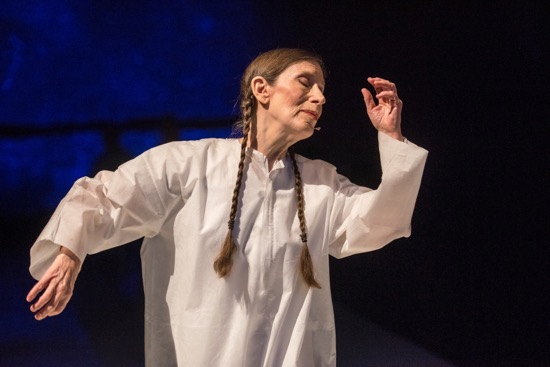
Meredith Monk in her Cellular Songs. Photo: Stephanie Berger.
When I began to search the Brooklyn Academy of Music’s website for images of Meredith Monk’s Cellular Songs, I went astray. I couldn’t categorize the work the way the site expected me to. If I clicked on “theater,” I couldn’t also click on “music.” When, with help, I found the photographs I sought, “theater,” “music,” and “dance” were all highlighted. It figures. If you look through the list of works that Monk has made since 1964, you’ll find, say, her 1969 Juice billed as a “Theater Cantata,” her 1976 Quarry characterized as “An opera.” the 1996 The Politics of Quiet as “A Music Theater Oratorio,” and most of her later works as “musical compositions.” But overlapping and weaving and bumping together and fading in and out of her compositions, these categories founder as absolutes.
“I work in between the cracks,” this extraordinary artist said in 1981, “where the voice starts dancing, where the body starts singing, where theater becomes cinema.”
(In case you wonder why I’m writing about Cellular Songs alongside the music critics, it may be because I first came to know Monk as a dancer-choreographer. She and Phoebe Neville were performing her 1965 Radar on a mixed bill at Dance Theater Workshop’s first tiny home on West 20th Street. They wore featureless gray masks without eyeholes and, in accord with an indeterminate structure, moved cautiously, beeping softly from time to time to convey their location to each other.)
Monk has long been thinking about the world and its seemingly irreconcilable differences. On a cellular level, there is more cooperation, even when renegade forces threaten to disrupt the status within a single human being. In this shimmering new piece, her themes are (as they have often been) companionship, cooperation, understanding. The performers are all women—not just the four singers (Ellen Fisher, Katie Geissinger, Allison Sniffen, and Jo Stewart)—but the ten members of the Young People’s Chorus of New York City, who don’t appear onstage until close to the end of the performance.
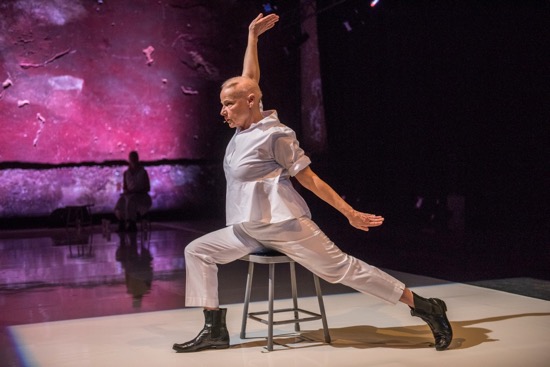
Ellen Fisher of Meredith Monk & Vocal Ensemble in Cellular Songs. Photo: Stephanie Berger.
The stage is a spare fire-and-ice place when Cellular Songs begins. In Monk and Yoshio Yabara’s installation design, as lit by Joe Levasseur, the white floor gleams like water, and the wall at the back glows red. A piano sits at the rear left side. Five straight-backed chairs can be moved wherever they’re needed. Before we can see clearly into the darkness, we’ve heard sounds: wind maybe, but also voices rhythmically whispering repeated vowels. When Monk, Geissinger, and Sniffin stand before us singing, they could almost be phantom astronauts; Yabara has costumed them in featureless, ballooning white coveralls and low-topped black boots. If Monk, flanked by the other two, takes small steps forward, they may back up, and vice versa. Although the design shifts, the impression is of a preparation for action.
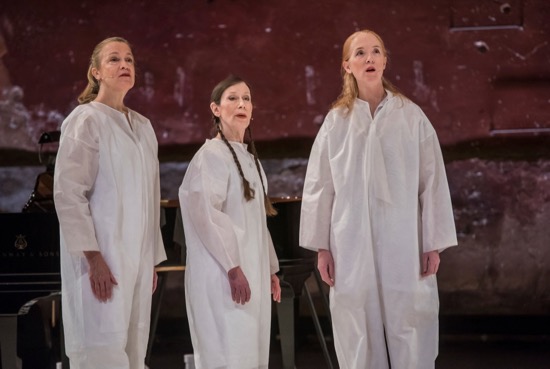
Katie Geissinger,Meredith Monk, and Allison Sniffin in Cellular Songs. Photo:
Stephanie Berger.
I have often thought of journeys as crucial to her vision, and I see them in Cellular Songs too. The performers gaze toward certain points near them and in the distance. The three sit on the floor the way you might sit around a campfire. They walk along together. Their wordless singing can suggest queries and answers or simultaneous separate statements that happen to fuse in a whole response. As always (or almost always) in Monk’s compositions, we hear sung syllables, not words, assembling into repeated motifs and set in several-part harmonies, or gently jostling ones. The women’s vocal tones are mostly pure, but sometimes breathy; once, Monk sounds like a little girl, cautious and unfinished.
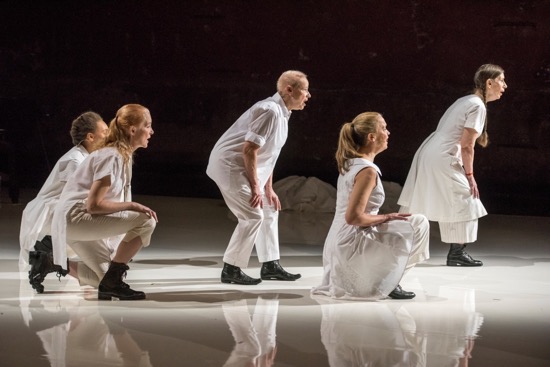
Meredith Monk’s Cellular Songs. Traveling together (L to R): Jo Stewart (partially hidden), Allison Sniffin, Ellen Fisher, Katie Geissinger, and Meredith Monk. Photo: Stephanie Berger.
When Fisher and Stewart stroll in to join the three, they’re holding hands and “conversing” as they go. While the others sit in two corners and sing, these two communicate through gesture—for example, Fisher whips an arm around, and Stewart (a newcomer to Monk’s ensemble) imitates the move. But they also dance separately, each working out her own pattern in the light that emanates, in part, from little reading lamps reflecting their beams on the shiny floor.
When Sniffin goes near the piano and begins playing a violin, Monk stands in a downstage square of light and, in that continuum of sound, begins a litany. “I am a happy woman,” she chants, weaving the air with her hands, sensuously enjoying the moment. But this woman is not only happy. She confirms, in turn, that she is also a hungry woman, a tender one, a sassy one, a patient one, a needy one, an honest one, a lying one, a dying one, a reckless one, and more. Every now and then, she throws her arms up and sings “Hey-nyo!”
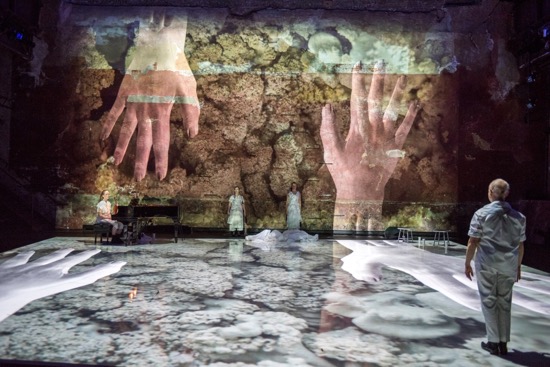
The hands begin their dance in Cellular Songs. Watching: Ellen Fisher. Photo: Stephanie Berger.
Midway through the piece, the women change their attire. Sniffin helps Monk out of her white suit, and the others fold their clothes and pile them up. They’re all still dressed in white, but wearing pants and simple shirts or tunics. Garbed thus, three gather around Sniffin, who’s now playing the piano, and lean in to touch certain keys. Monk stands to play a keyboard. This collaborative musical ensemble coalesces, while Katherine Freer’s video design (cinematography by Ben Stechschulte) plays on the backdrop and floor. Eventually, Identical pairs of hands, arranged like spokes in a wheel, play games, and you may begin to see them as combatants becoming the companions they have to be in order to survive— thumbs fencing, palms coming together.
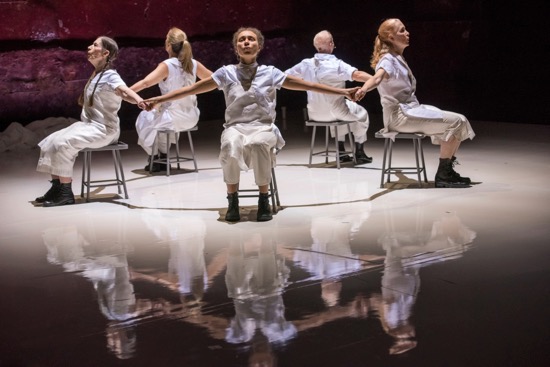
Meredith Monk & Vocal Ensemble in Monk’s Cellular Songs. L to R: Meredith Monk, Katie Geissinger, Jo Stewart, Ellen Fisher, Allison Sniffin. Photo: Stephanie Berger.
There’s been no strife between the women. We see them traveling as a group, sometimes facing forward, sometimes back, weaving, murmuring, pausing, becoming vigorous, stamping. Their voices—mostly sweet—ask and answer, challenge, and discuss. They sit in a circle on the chairs, backs to one another, hands outstretched to touch, their melodies—jostling, jibing, cohabiting, gently clashing—meld the way ingredients merge in a stew; they retain their identities but create a new whole. That the five women sense, rather than see one another, makes their solidarity seem even firmer, needing no confirmation.
Near the end, they lie down, as if ready to sleep. But now, the offstage chorus of women (at least one of them still a child) gradually joins them onstage, walking in various directions. These singers too wear white clothing. Five people have become fifteen, and when they all lie down to sleep, and the lights fade to black, you imagine that when they awaken, they may have multiplied again, with no loss of strength or purpose or voices that peaceably intertwine. Amen.

Lovely lovely writing, thank you Deborah. And for the introductory paragraph–I would add to that that categories, pigeonholes, are not for artists and their work but for the people who write about them and it, for some audience members, listeners, viewers. And I couldn’t agree with you more about Monk’s journeying. I saw her work for the first time in 1979, charged with doing an essay review on post-modern dance in NY for Dance Mag. I concluded that Monk was the only truly avant-garde artist among them and they included Lucinda Child and David Gordon.